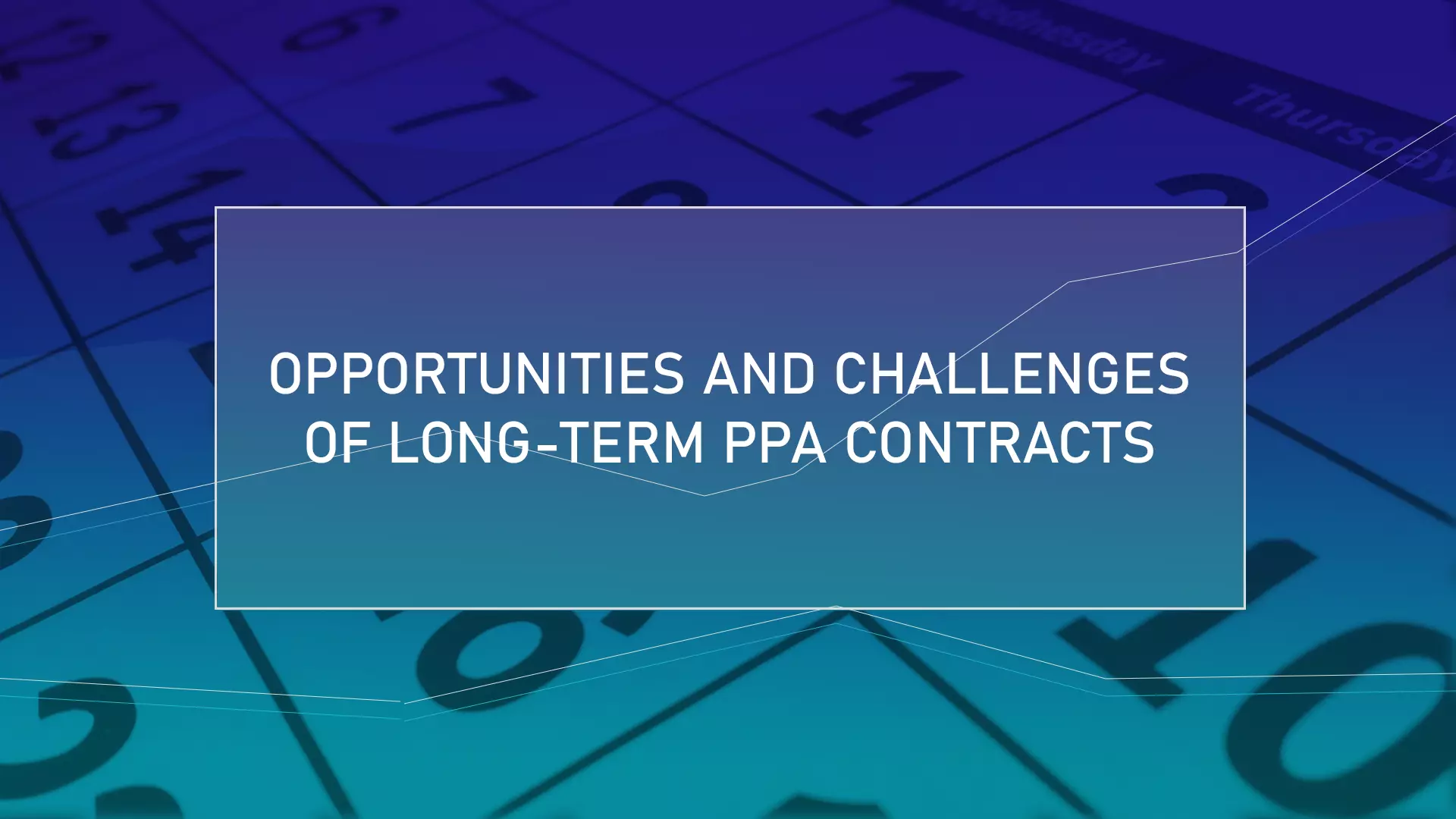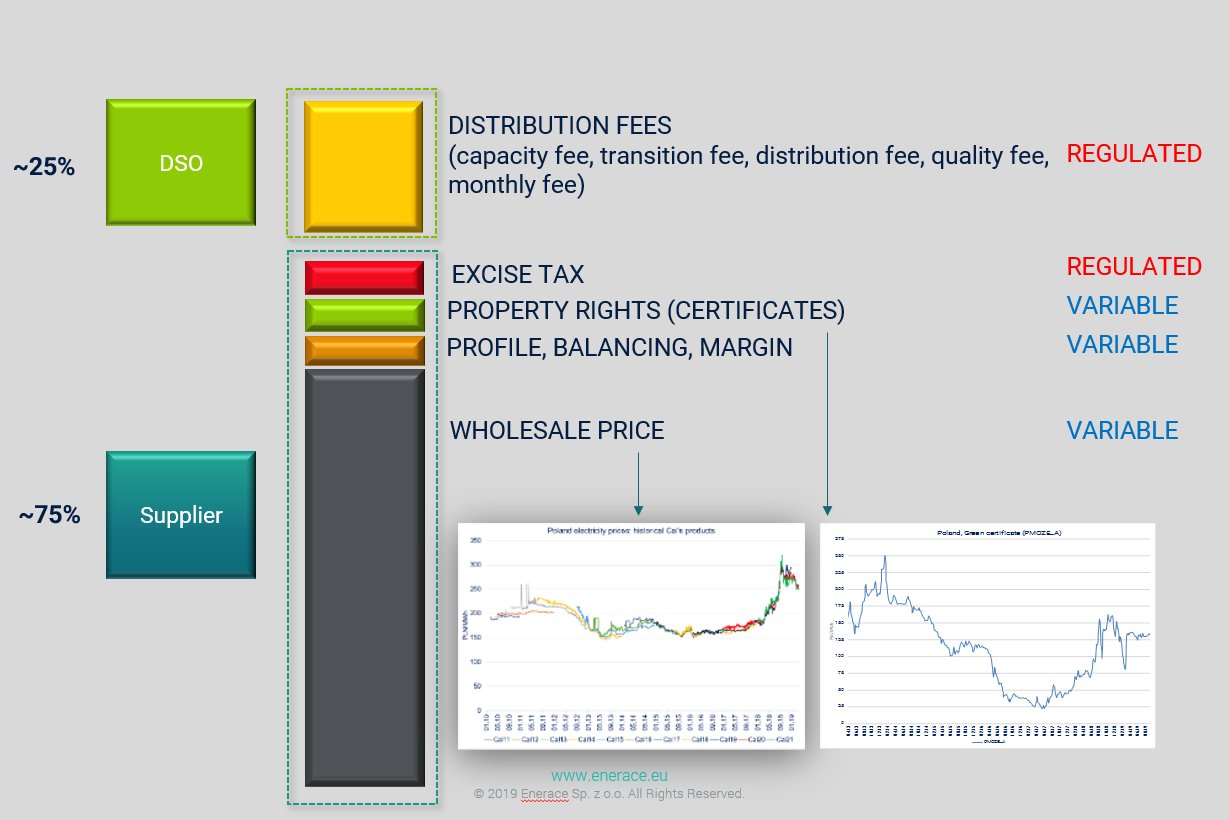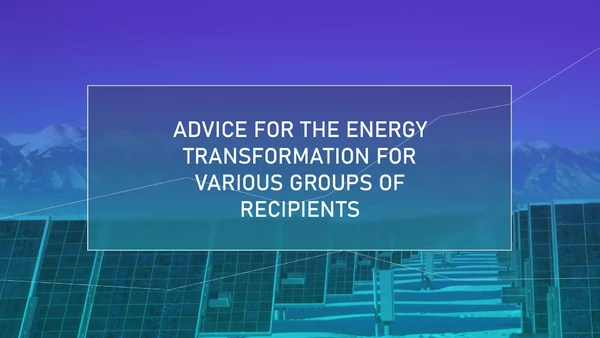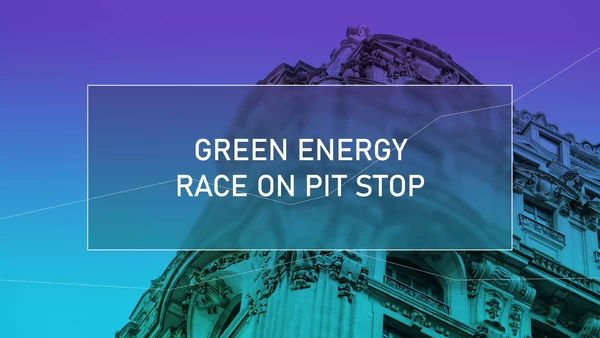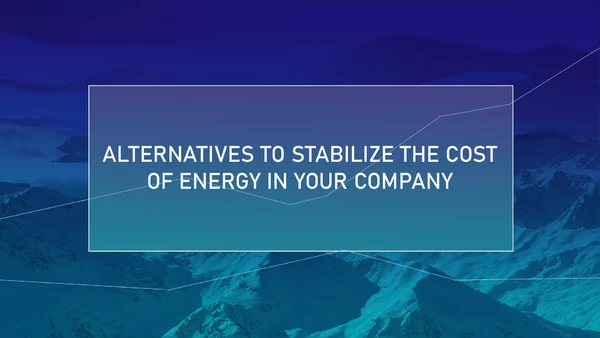Let us remind you that due to the fact that the Polish energy sector is mainly based on coal (about 80% of the production is based on this fuel), CO2 prices have influenced, and there is nothing to hide, they will probably significantly affect the formation of energy price levels in Poland. Of course, it is not said that prices of CO2 emission rights must only increase over the years. You can find a lot of rational information for and against increases or decreases in CO2 prices. However, given the pace of changes in Poland's energy mix, it should be assumed that changes in CO2 prices will affect electricity prices in Poland over the next decade.
End customers' interest in alternatives
On August 29, 2019, a conference was held in Katowice regarding long-term contracts for the purchase of green energy in the Corporate Power Purchase Agreement (cPPA) model. Backstage discussions showed that, consumer, despite their absence at the conference, are interested in the topic of cPPA, but few of them are currently concretising plans and in fact concluding such contracts. Why are end users interested in PPAs? What actually blocks them from finalizing such contracts?
Theory
What are Corporate Power Purchase Agreements (cPPA)?
The legal definition of PPA is included in the Directive of the European Parliament and of the Council (EU) 2018/2001 of 11 December 2018 on the promotion of the use of energy from renewable sources "RED II": "contract for the purchase of renewable electricity" means the contract under which a natural or legal person agrees to purchase renewable electricity directly from the electricity producer. There is no similar definition in the Polish legal order, but it should be emphasized that the provisions of the above directive should be implemented in the Polish legal order by 30 June 2021. However, taking into account the market expectations, we want to start a discussion on creating a cPPA definition just as a response to these expectations.
First of all, it should be pointed out that in our opinion it should remain an unregulated contract, which should be based mainly on the principle of freedom of contract and general principles of obligations in civil law. Therefore, there is no need to codify this matter into a separate act.
Secondly, it should primarily respond to the needs of both end users and producers. In our opinion, this is the largest area for discussion in this respect, but this goes beyond the subject of this article. We want to emphasize that, as indicated above, cPPA agreements are primarily to regulate the rules for the supply and collection of electricity produced from renewable energy sources and the principles of settlements and liability of the parties. In our opinion, at present, such a definition of cPPAs is sufficient and is to be the beginning of further work in this area. In this case, the contracts and the market participants should formulate contractual provisions tailored to their needs. Nevertheless, a characteristic aspect of cPPA contracts is that they are long-term contracts, usually between 5 and 15 years.
Among the basic types of cPPAs there are:
On-site cPPA
From a practical point of view, in the case of a cPPA contract for a source directly connected to the customer's installation (the so-called cPPA on-site), the issue of balancing energy produces from the installation and taken from the grid seems obvious:
1. cPPA developer: receives from the end-consumer: PRICE (agreed with the end-consumer) x ENERGY CONSUMPTION (amount of energy fed into the grid).
2. End-consumer: energy charges with :
a) Energy supplier: PRICE (agreed with supplier) x ENERGY CONSUMPTION (amount of energy taken from the grid). In the case of overproduction, the price agreed with the supplier.
b) Distribution company (DSO): PRICE (tariff) x ENERGY CONSUMPTION (amount of energy taken from the grid).
c) cPPA developer: PRICE (agreed with cPPA developer) x ENERGY CONSUMPTION (amount of energy fed into the grid).
3. Supplier: receives from the end-consumer: PRICE (agreed with the end-consumer) x ENERGY CONSUMPTION (amount of energy taken from the grid). In the case of overproduction, the price agreed with end-consumer.
4. Distribution company (DSO): receives from the end-consumer:
PRICE (tariff) x ENERGY CONSUMPTION (amount of energy taken from the grid).
Off-site cPPA
In the case of a cPPA contract for a virtual source, i.e. not connected to the customer's installation (so-called off-site cPPA), the issue of energy balancing is not so obvious to the end-consumer. Therefore, it is more space for differential contract, where the payer to a developer, e.g. an offshore wind farm, is not the Settlement Manager (Polish state) but a private entity.
1. cPPA developer: receives payment from the end-consumer for selling the whole produced energy to the grid in relation to the current price on the market (Polish Power Exchange).
a) If the market price is higher than the price agreed with the end-consumer, then the developer pays the end-consumer the difference to the base price agreed between the developer and the end-consumer.
b) When the market price is lower than the price agreed with the end-consumer, then the end-consumer pays to the Developer the difference to the base price agreed between the developer and the end-consumer.
2. End-consumer: energy charges with:
a) Supplier: PRICE (agreed with supplier) x ENERGY CONSUMPTION (amount of energy taken from the grid).
b) Distribution company (DSO): PRICE (tariff) x ENERGY CONSUMPTION (amount of energy taken from the grid).
c) cPPA developer: in accordance with points 1a and 1b.
3. Supplier: receives from the end-consumer: PRICE (agreed with the end-consumer) x ENERGY CONSUMPTION (amount of energy taken from the grid).
4. Distribution company (DSO): receives from the end-consumer: PRICE (tariff) x ENERGY CONSUMPTION (amount of energy taken from the grid).
Off-site cPPA, so called „near site direct wire”
As a type of cPPA off-site contract, it is worth pointing to "Near site direct wire". In this type of contracts, electricity is supplied through a dedicated cable line between the Developer installation and the Customer. In the case of settlements, the situation is no longer so obvious because currently ERO is demanding the appearance of another DSO (Developer).
1. cPPA developer: receives from the end-consumer: PRICE (agreed with the end- consumer) x ENERGY CONSUMPTION (amount of energy fed into the grid).
2. cPPA developer (DSO): receives from the end-consumer: PRICE (developer's DSO tariff) x ENERGY CONSUMPTION (amount of energy taken from the Developer DSO network).
3. End-consumer: energy charges from:
a) Supplier: PRICE (agreed with the supplier) x ENERGY CONSUMPTION (amount of energy taken from the grid). In the case of overproduction, the price agreed with the supplier.
b) Distribution company (DSO): PRICE (tariff) x ENERGY CONSUMPTION (amount of energy taken from the grid).
c) cPPA developer: PRICE (agreed with the cPPA developer) x ENERGY CONSUMPTION (amount of energy fed into the grid).
d) cPPA developer (DSO): PRICE (DSO Developer tariff) x ENERGY CONSUMPTION (quantity of energy consumed from the Developer’s DSO network).
4. Supplier: receives from the end-consumer: PRICE (agreed with the end-consumer) x ENERGY CONSUMPTION (amount of energy taken from the grid). In case of overproduction price agreed with the end-consumer.
5. Distribution company (DSO): receives from the end-consumer: PRICE (tariff) x ENERGY CONSUMPTION (amount of energy taken from the DSO grid).
How to use cPPA
Right now, investments in green energy are of particular importance, when from October 1, 2020 a new item will appear on the electricity distribution bills: the capacity market fee. According to the Ministry of Energy, this fee will amount to approximately 45 PLN/MWh on average and will be charged on the electricity consumed by the end-consumer during the hours specified in the ordinance of the Minister of Energy. Considering the problems of the Polish energy sector regarding the production of electricity during peak hours, probably during peak hours (7-20) this charge will appear. However, solar or wind installations can significantly reduce energy consumption at the peak, which will bring measurable benefits: firstly, in reducing the distribution variable fee (self-production) and secondly - in reducing the capacity fee.
In terms of procurement, cPPA is one of the alternatives to stabilize the cost of electricity in the long term with a minimum investment.
It is the cPPA developer that performs installations at its cost and expects monthly revenues for the following years, for which it will cover financing costs, including leasing, risk costs and margin.
Basic differences between the energy procurement model from the market and auto-generation and On-site / Off-site PPA is shown in the following illustration:
The big advantage of cPPA contracts is the lack of investment costs from the end-consumer side. It is the developer who undertakes any discussions with financing institutions. On the other hand, the big advantage of investing in auto-generation are considerable energy cost savings resulting from the fact that after the payback period, the installation is already owned by the customer. In both cases, i.e. auto-production and cPPA contracts, we have a real chance to reduce bills, for at least part of the energy consumed, with actual investment in renewable energy sources.
cPPA price formulas
As many consumers as many possible price formulas. The most obvious distinction from the point of view of risk management when purchasing energy is a fixed price and variable price.
We also seen many varieties:
- Fixed price
- Fixed price with indexation
- Variable price linked to market average
- Variable price linked to market average minus discount
- Variable price linked to spot price
- Variable price with lower and upper limit.
Setting a formula with a minimum price level may be important for the developer from the point of view of obtaining financing. Nevertheless, it depends on the agreement between the developer and the end-consumer how the price formula is determined and detailed terms and conditions will be valid.
Challenges with cPPA
When analysing the topic related to cPPA agreements, it is undoubtedly necessary to identify challenges. Due to the fact that these types of contracts are rare in Polish business transactions, their conclusion and performance will encounter a number of difficulties. The most important will be economic, business and technological challenges, but legal challenges will also have a significant impact on the development of cPPA agreements.
Current legal challenges related to cPPAs are:
- (un) stable legislation - in our opinion this is a key challenge facing both market participants and the legislator. Considering even the events related to support in the form of yellow, red and green certificates, the "Anti-windmills act". In Czech Republic, retrospective provisions were introduced a few years ago. Both investors in renewable energy installations and consumers point to the lack of stable legislation as one of the first problems. This is fundamental for both investors and investment financing entities. For the development of cPPA contracts, the so-called "Banking" of cPPA contracts. In this regard, financing institutions pay close attention when assessing credit risk. Therefore, clear and stable rules are undoubtedly a key aspect that can affect the development of CPP contracts
- direct line – taking into account types of cPPAs contracts and regulations in Poland regarding the direct power line, it can be pointed out that leaving the President of the Energy Regulatory Office free to consent to its construction may hinder the development of cPPAs of the "Near site direct wire" type. From the point of view of the parties to the cPPA agreement, a direct line connecting the installation of electricity production from renewable energy sources with the end-consumer can be an attractive solution that will reduce the costs associated with the transmission / distribution of electricity. In our opinion, it is necessary in this regard to regulate in which situations the President of the Energy Regulatory Office may refuse to grant consent, and when he is not entitled to such permission.
- Support for cPPA contracts - in this case, apart from the legal aspect, there is also an economic one. Without appropriate regulations and legal solutions, it will not be possible to support cPPA contracts. In this case the so-called incentive effect. At the current stage of application of cPPA contracts, it is difficult to propose a support system that would satisfy all parties to the contract and meet the requirements related to public aid. Analyzing the Polish energy market, one can point to various solutions that support. An example would be concessions for the energy-intensive industry, which in our opinion may be the basis for creating a support system for cPPA contracts. Leave the detailed analysis related to the support proposal open and we will come back to it in a separate article.
In addition to the legal challenges mentioned above, there are others, such as regulations limiting the development of onshore wind farms or a problem related to the condition of the transmission / distribution network. However, these issues remain outside the area closely related to cPPAs.
Regardless of the challenges and legal barriers, we would like to draw your attention to the awareness of market participants. Everyone sees a number of risks. From the point of view of responsibility, this is obviously justified, but in order for cPPA agreements to develop, certain barriers and stereotypes must be overcome. We know from our own experience that the supply of utilities, which is undoubtedly electricity in the OTF formula ("over the fence"), may prove to be an excellent solution for parties, while securing all risks.
cPPA or participation in the auction in 2019
A common question from producers or investors in renewable energy installations is which model is the most advantageous, i.e. joining the auction in 2019 or concluding a cPPA agreement. In this case, several factors should be taken into account that will determine the adopted solution:
- investment financing method (which financing institutions prefer) - as we have pointed out above, an important element is the "banking" of investments. Financing institutions are approaching the support systems guaranteed by the state with a high degree of caution. Additionally, at the stage of talks on cPPA contracts, financing institutions often participate in talks between the parties and have a real impact on the results of these talks. Therefore, observing the market, one can be tempted to say that in this case cPPA agreements will gain the advantage.
- investor / producer expectations - in this case the producer and investor will expect the stability of electricity reception at the highest possible price. Analysing the last auctions, the question arises whether all auction winners from previous years will be optimistic about production profits after starting the installation. Here we will make a bold thesis that some of the entities whose bids won the auction will not achieve the assumed financial profits. The proposed prices, after conducting the analyses, do not allow to state that they will bring measurable benefits. In the case of cPPA contracts, there are at least several mechanisms to ensure that the price of electricity sold is indexed depending on the market situation. Such solutions can be security for both the producer and the end-consumer, which allows the contract to be adapted to the needs of both parties. In this case, also cPPA contracts have an advantage over the auction system;
- expectations of the end-consumer - when it comes to the expectations of end-consumer, they can be divided into two groups, for the first the most important aspect will be the financial issue (purchase at the lowest price), while for the second the most important will be security of supply. Regardless of the expectations of end-consumer, this is undoubtedly an aspect that negatively affects the development of cPPA contracts. We know from practice that the expectations of the parties at some point in negotiations do not allow the conclusion of a contract. Therefore, this is an aspect that speaks in favor of entering the next auctions, because there is no guarantee that the cPPA agreement will be completed;
- financial aspect - what are we talking about more and more often, is it a certain price guarantee from state auctions or a flexible price in cPPA contracts? In the current situation, there is no perfect solution. Each entity must individually carry out a risk analysis and business analysis and make a decision. However, from a financial point of view, cPPAs offer much more opportunities and therefore appear more attractive.
The answer to the question asked above cannot be unambiguous. However, we encourage you to analyse the available solutions and perform a thorough analysis. Only with this approach can any investor / producer answer this question with full conviction.
Summary
Should all consumers set prices long-term and stabilize energy costs in the long horizon? Not always. The goals of energy procurement can be multiplied. Here are a few
of them:
- Long-term stabilization of my energy budget.
- My energy prices are following the economic situation and average energy prices on the market.
- My energy prices should be better than those of my competition.
- Eliminating carbon footprint in the manufactured products.
Determining the right goal for your business is the key. Energy intensive companies will manage the procurement of energy differently, where the share of energy cost in the margin or product price is the key. Different goal will choose a consumer, where the cost of energy is significant, but does not affect margins, the price of their own product or competitiveness.
CPPAs seem to be a very interesting alternative or complement to the existing procurement model.
Signing a contract for the supply of energy for several years is a big challenge. Before starting talks about cPPA, it is worth to approach the comprehensive analysis and prepare for yourself to implementation.
An example plan is presented below:
Prepare a long-term energy procurement strategy. Only then will we know what the real goals of our company are. What should our company care about the most? What is the relationship between energy cost and final product price? Is it possible or how quickly can competition affect our business, when energy prices will change? If a company is interested in PPAs, then based on what price model (spot, discount, fixed price?). All these elements must be known prior to any talks regarding cPPA.
Verification of the energy source. Checking the profitability of investments in a given source, auto-generation or cPPA. Of course, respecting the previously defined strategy.
Verification of formal and legal issues related to the selected technology and model.
Tender for a cPPA supplier or own installation contractor (and verification of external financing offers).
Implementation of the cPPA agreement or own installation.
Long-term contracts in the OTF formula ("over the fence") for the supply of electricity are undoubtedly an opportunity for development, both for renewable energy installations and for entrepreneurs. The social aspect is also of special importance here. Taking part in a series of meetings, we noticed that little attention is paid to issues related to clean air, care for the environment. This aspect should be the starting point for the development of cPPAs.
The above article is to be the basis for starting a specific debate on the development of cPPA agreements, in the following articles we will discuss specific issues in detail to introduce cPPA agreements to the practical application stage.
Let's discuss about it!
Authors: Bartosz Palusiński and Piotr Kolasa (Polowiec i Wspólnicy Sp. j.)

